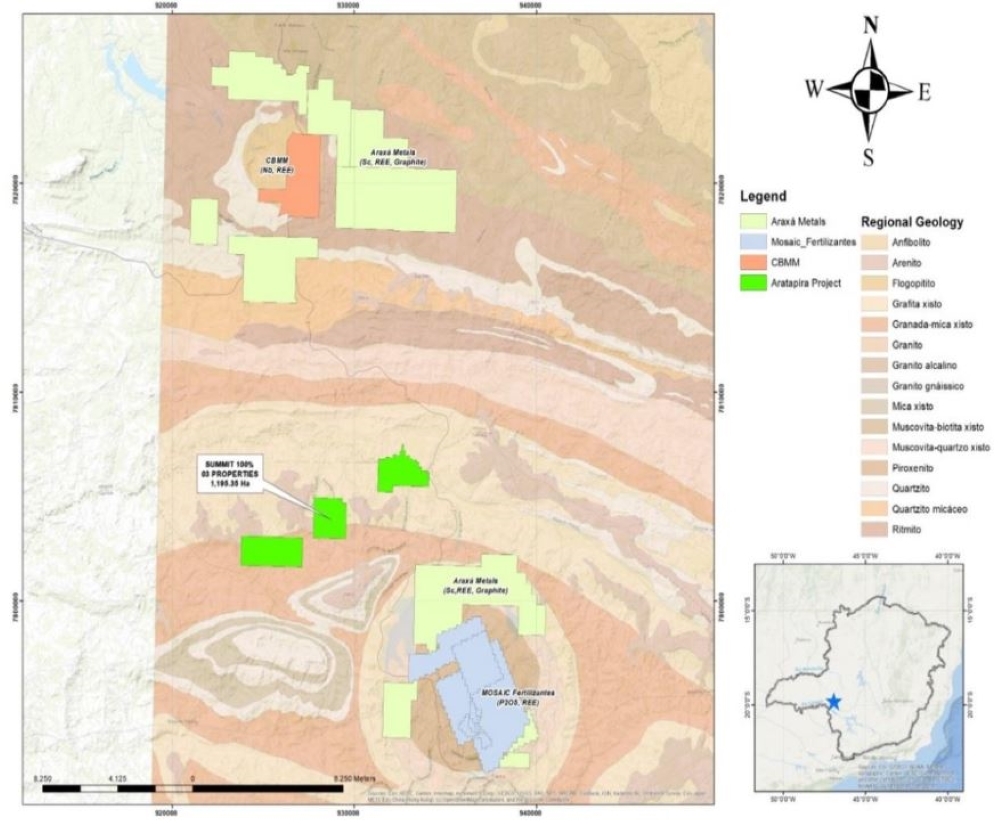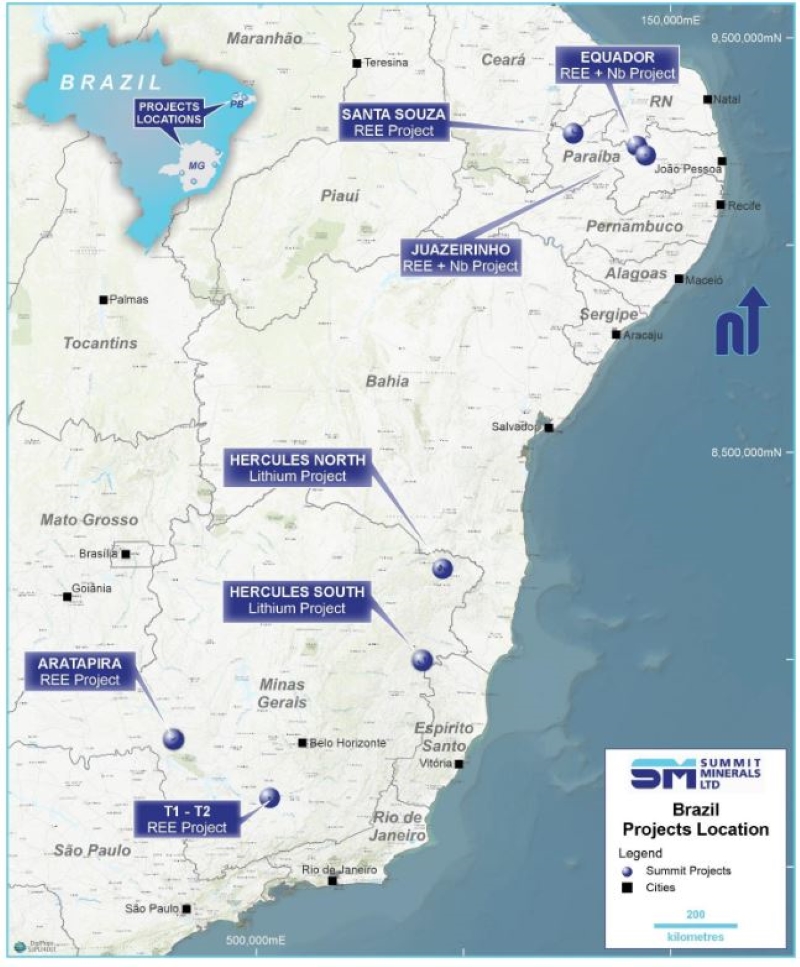35.54% niobium?! ASX explorer aims to scale the Summit of Brazil’s critical minerals sector

Summit has snapped up tenements in Brazil’s prolific Minas Gerais mining
- Summit Minerals (ASX:SUM) to purchase niobium, lithium and rare earths (REE) projects in Brazil
- Tenements cover 292.2km2 across 14 granted and applied licenses
- First-pass exploration at Aratapira REE project identifies 200m saprolite-clay system
- Large LCT pegmatites identified with in-country exploration team ready to go
Special Report: With fellow ASX explorers already enjoying big success in Brazil, Summit Minerals has snapped up a minerals-rich 292.2km2 tenement package in the South American country prospective for lithium, niobium, and rare earths (REE).
Summit Minerals’ (ASX:SUM) new managing director Gower He – the ‘energy transition-focused’ specialist of Mitsui fame – is wasting no time jumping into burgeoning mining regions.
After methodically scouring the world for projects, SUM has landed in Brazil, where the government recently started up a US$202.7m fund for critical minerals projects too – a big sign of support for foreign investment into its mining sector.
“The transition to a low-carbon global economy is driving demand for critical minerals essential to the electrification of transportation and expansion of renewable energy. Brazil stands out as an attractive terrain for foreign investment in this context,” Brazil’s mining association ministry said in a statement.
The explorer is expanding once again after recently increasing its tenure by 84% in the Ponton Creek uranium district in WA and is progressing other core operations such as the Phillips River and Castor lithium projects, as well as the Ahmed antimony project.
Brazil holds 98% of the world’s niobium reserves
SUM’s new niobium and REE tenement packages consist of the Juazeirinho, Equador, Aratapira, Santa Sousa and T1/T2 projects, which cover a combined 107.47 km2 across 11 granted tenements.
The Paraiba projects, including Equador and Juazeirinho, are situated in Borborema Pegmatitic Province (BPP) in northeast Brazil.
The province represents one of the world’s most important sources of tantalum, REEs and beryllium, as well as producing significant quantities of gemstones.
Brazil also hosts ~98% of the world’s reserves of niobium, a high value element used in things like jet engines and rockets, beams and girders for construction, superconducting magnets, electronics, and the nuclear industry.
Experts believe that niobium can also replace cobalt in battery applications, where Brazil is leading the charge.
At Juazeirinho, exceptional grades up to 35.54% niobium (Nb2O5) and 1.408% partial rare earth oxide (PREO) were produced in panned concentrates from pegmatite and sediment samples.
At Equador, 30.34% Nb2O5 and 1.513% PREO were identified.
SUM says nine REEs were analysed by the previous owner and used in PREO calculations, implying higher TREO (total rare earth oxide) values are “probable”.
“Numerous LCT-pegmatite bodies were observed at Equador and Juazeirinho, indicating good potential for columbite/tantalite, lithium, with significant concentrations of niobium across these projects and Equador in Paraiba State,” the company says.
200m clay system found at Aratapira
The explorer has already identified a large-scale surface saprolite clay system at the Aratapira REE project in southwest Minas Gerais which spans parts of the Alto Paranaíba Igneous Province – where the world’s niobium is largely produced.
Highly weathered saprolite clay is crucial in discovering ionic adsorption clay (IAC) deposits which often contain high grades of valuable magnetic rare earths.
It’s nestled between CBMM’s world-class niobium and ultra high-grade hard rock REE deposit and Mosaic’s phosphate-REE operation.
SUM says it will carry out an aggressive Phase 1 exploration program which will pave the way for a cost-effective maiden Augur drill program shortly after.

The Aratapira REE project and surrounding projects. Pic supplied: (SUM)
The lithium package
SUM has also snapped up 12 exploration permits and two exploration applications covering 185km2 in the northeast within the famed Brazilian Lithium Valley in Minas Gerais, Brazil where 85% of Brazil’s known lithium resources are located.
The lithium package comprises two project areas, Hercules North and Hercules South in the Araçuaí orogen, there are numerous artisanal mines which exist within the package where laefer LCT pegmatites have been identified.

Summit’s new Brazilian critical minerals project locations. Pic supplied: (SUM)
“We are extremely pleased to acquire these highly prospective tenements and anticipate the niobium, REE and lithium projects will enhance our company’s status as a critical mineral explorer and developer,” SUM MD Gower He says.
“Over the last few months, we have assessed many options for project acquisition and have chosen these highly prospective and large-scale projects within the established mining-friendly jurisdiction of Brazil.
“Additionally, Brazil, being a relatively geopolitically neutral jurisdiction, should provide us with unrestricted access to global off-take and funding options, giving our projects the best chance of success within the macro environment.
“In addition to some of the strong historical grades, we received great observational reports from our recently completed on-site DD, from which we await rock chip and soil assay results.
“Expansive exploration programs are already being planned as we look to rapidly develop our projects, giving ourselves the highest chance of success.”
This article was developed in collaboration with Summit Minerals, a Stockhead advertiser at the time of publishing.
This article does not constitute financial product advice. You should consider obtaining independent advice before making any financial decisions.
Related Topics

UNLOCK INSIGHTS
Discover the untold stories of emerging ASX stocks.
Daily news and expert analysis, it's free to subscribe.
By proceeding, you confirm you understand that we handle personal information in accordance with our Privacy Policy.








